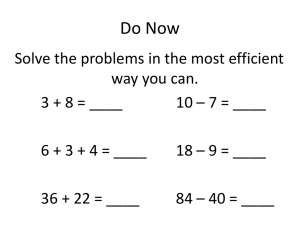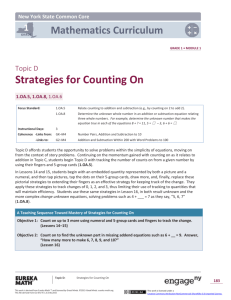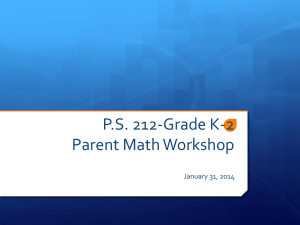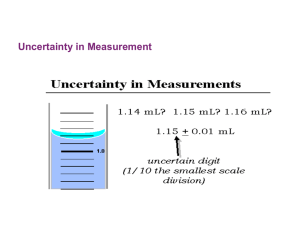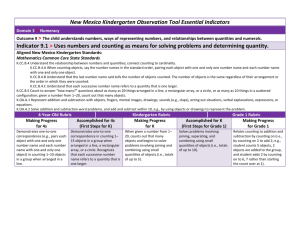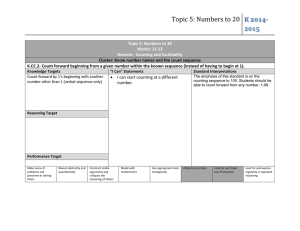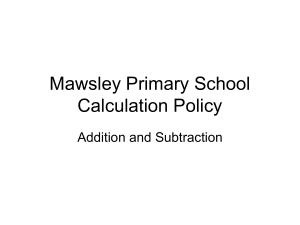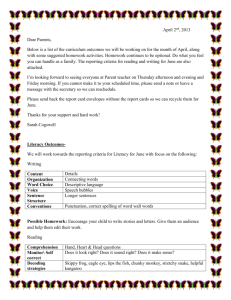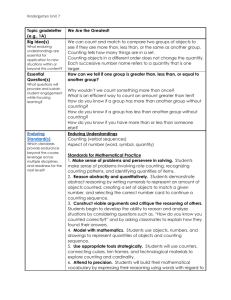CA PRESCHOOL LEARNING FOUNDATIONS FOR MATHEMATICS
advertisement
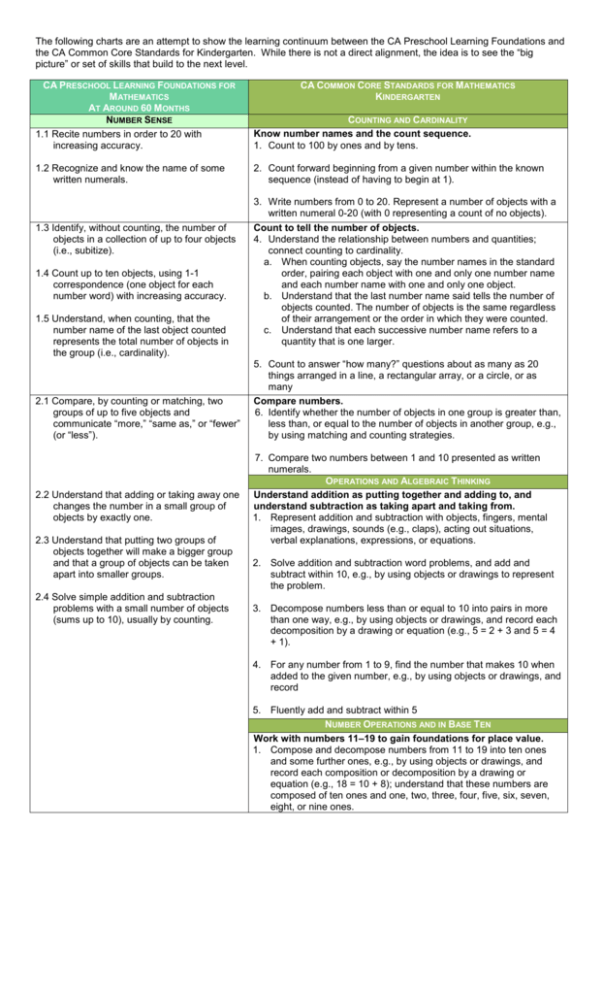
The following charts are an attempt to show the learning continuum between the CA Preschool Learning Foundations and the CA Common Core Standards for Kindergarten. While there is not a direct alignment, the idea is to see the “big picture” or set of skills that build to the next level. CA PRESCHOOL LEARNING FOUNDATIONS FOR M ATHEMATICS AT AROUND 60 MONTHS NUMBER SENSE 1.1 Recite numbers in order to 20 with increasing accuracy. COUNTING AND CARDINALITY Know number names and the count sequence. 1. Count to 100 by ones and by tens. 1.2 Recognize and know the name of some written numerals. 2. Count forward beginning from a given number within the known sequence (instead of having to begin at 1). 1.3 Identify, without counting, the number of objects in a collection of up to four objects (i.e., subitize). 1.4 Count up to ten objects, using 1-1 correspondence (one object for each number word) with increasing accuracy. 1.5 Understand, when counting, that the number name of the last object counted represents the total number of objects in the group (i.e., cardinality). 2.1 Compare, by counting or matching, two groups of up to five objects and communicate “more,” “same as,” or “fewer” (or “less”). 2.2 Understand that adding or taking away one changes the number in a small group of objects by exactly one. 2.3 Understand that putting two groups of objects together will make a bigger group and that a group of objects can be taken apart into smaller groups. 2.4 Solve simple addition and subtraction problems with a small number of objects (sums up to 10), usually by counting. CA COMMON CORE STANDARDS FOR MATHEMATICS KINDERGARTEN 3. Write numbers from 0 to 20. Represent a number of objects with a written numeral 0-20 (with 0 representing a count of no objects). Count to tell the number of objects. 4. Understand the relationship between numbers and quantities; connect counting to cardinality. a. When counting objects, say the number names in the standard order, pairing each object with one and only one number name and each number name with one and only one object. b. Understand that the last number name said tells the number of objects counted. The number of objects is the same regardless of their arrangement or the order in which they were counted. c. Understand that each successive number name refers to a quantity that is one larger. 5. Count to answer “how many?” questions about as many as 20 things arranged in a line, a rectangular array, or a circle, or as many Compare numbers. 6. Identify whether the number of objects in one group is greater than, less than, or equal to the number of objects in another group, e.g., by using matching and counting strategies. 7. Compare two numbers between 1 and 10 presented as written numerals. OPERATIONS AND ALGEBRAIC THINKING Understand addition as putting together and adding to, and understand subtraction as taking apart and taking from. 1. Represent addition and subtraction with objects, fingers, mental images, drawings, sounds (e.g., claps), acting out situations, verbal explanations, expressions, or equations. 2. Solve addition and subtraction word problems, and add and subtract within 10, e.g., by using objects or drawings to represent the problem. 3. Decompose numbers less than or equal to 10 into pairs in more than one way, e.g., by using objects or drawings, and record each decomposition by a drawing or equation (e.g., 5 = 2 + 3 and 5 = 4 + 1). 4. For any number from 1 to 9, find the number that makes 10 when added to the given number, e.g., by using objects or drawings, and record 5. Fluently add and subtract within 5 NUMBER OPERATIONS AND IN BASE TEN Work with numbers 11–19 to gain foundations for place value. 1. Compose and decompose numbers from 11 to 19 into ten ones and some further ones, e.g., by using objects or drawings, and record each composition or decomposition by a drawing or equation (e.g., 18 = 10 + 8); understand that these numbers are composed of ten ones and one, two, three, four, five, six, seven, eight, or nine ones.


